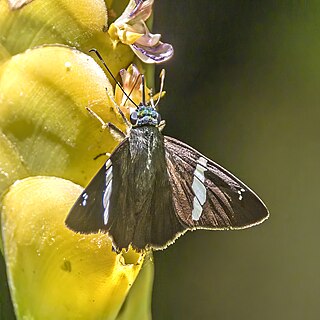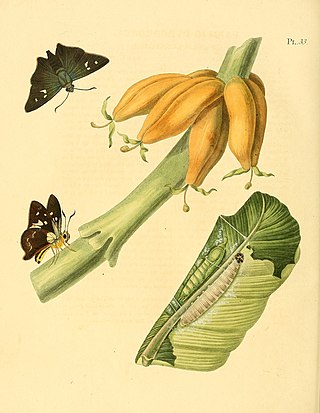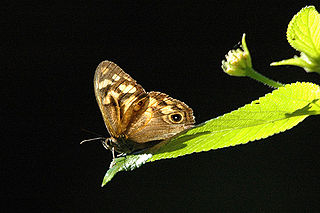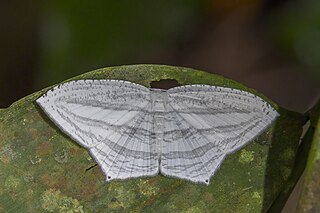
Striga, commonly known as witchweed, is a genus of parasitic plants that occur naturally in parts of Africa, Asia, and Australia. It is currently classified in the family Orobanchaceae, although older classifications place it in the Scrophulariaceae. Some species are serious pathogens of cereal crops, with the greatest effects being in savanna agriculture in Africa. It also causes considerable crop losses in other regions, including other tropical and subtropical crops in its native range and in the Americas. The generic name derives from Latin strī̆ga, "witch".

Pompanos are marine fish in the genus Trachinotus in the family Carangidae. Pompano may also refer to various other, similarly shaped members of the Carangidae, or the order Perciformes. Their appearance is of deep-bodied fishes, exhibiting strong lateral compression, with a rounded face and pronounced curve to the anterior portion of their dorsal profile. Their ventral profile is noticeably less curved by comparison, while their anterior profile is straight-edged, tapering sharply to a narrow caudal peduncle. Their dorsal and anal fins are typically sickle-shaped, with very long anterior rays and a succession of much shorter rays behind, with a similarly long & curved, deeply forked tail which has a narrow base. They are typically overall silvery in color, sometimes with dark or yellowish fins, and one or a few black markings on the side of their body. They are toothless and are relatively large fish, up to about 1.2 m (3.9 ft) long, although most species reach no more than half or two-thirds of that size. They are found worldwide in warmer seas, sometimes also entering brackish waters.

Ceratomia is a genus of hawkmoths. The genus was erected by Thaddeus William Harris in 1839. Species include:

A parasitic plant is a plant that derives some or all of its nutritional requirements from another living plant. They make up about 1% of angiosperms and are found in almost every biome. All parasitic plants develop a specialized organ called the haustorium, which penetrates the host plant, connecting them to the host vasculature – either the xylem, phloem, or both. For example, plants like Striga or Rhinanthus connect only to the xylem, via xylem bridges (xylem-feeding). Alternately, plants like Cuscuta and some members of Orobanche connect to both the xylem and phloem of the host. This provides them with the ability to extract resources from the host. These resources can include water, nitrogen, carbon and/or sugars. Parasitic plants are classified depending on the location where the parasitic plant latches onto the host, the amount of nutrients it requires, and their photosynthetic capability. Some parasitic plants can locate their host plants by detecting volatile chemicals in the air or soil given off by host shoots or roots, respectively. About 4,500 species of parasitic plants in approximately 20 families of flowering plants are known.

Striga asiatica, the Asiatic witchweed or the red witchweed, is a hemiparasitic plant in the family Orobanchaceae. It is native to Asia and sub-Saharan Africa, but has been introduced into other parts of the world including Australia and the United States. Asiatic witchweed is a serious agricultural pest, as it parasitises important crop species, including corn, rice, sorghum, and sugar cane, often causing substantial yield reductions.

Eurema is a widespread genus of grass yellow butterflies in the family Pieridae.

Arcas is a genus of butterflies in the family Lycaenidae. The species of this genus are found in the Neotropical realm.

Lamprospilus is a Neotropical genus of butterfly in the family Lycaenidae.

Epargyreus is the genus of flasher butterflies, in the subfamily Eudaminae of skipper butterflies. The species are found in the Nearctic and Neotropical realms.

Autochton is a genus of skipper butterflies. They belong to the subfamily Eudaminae, which was long included with the spread-winged skippers (Pyrginae) as a tribe. They are found from Mexico to South America.
Corynitis is a monotypic moth genus of the family Erebidae. Its only species, Corynitis penicillalis, is found in Rio de Janeiro, Brazil. Both the genus and the species were first described by Carl Geyer in 1832.

Polites is a genus of North American butterflies of the family Hesperiidae (skippers), subfamily Hesperiinae.
Moeris is a genus of skippers in the family Hesperiidae.

Telemiades is a genus of Neotropical butterflies in the family Hesperiidae.

Thracides is a Neotropical genus of grass skippers in the family Hesperiidae.

Tetragonus catamitus, the common butterfly moth, or Philippine callidulid moth, is a moth of the family Callidulidae. It was first described by Carl Geyer in 1832. Noted from Taiwan, north-eastern India, south-west India, the Andaman and Nicobar Islands, Sri Lanka, the Tenasserim Hills of Myanmar and from Java. They are day-flying moths that can be easily mistaken for a butterfly due to the position in which they hold their wings.

Doryodes bistrialis, the double-lined doryodes moth, is a moth of the family Erebidae. The species was first described by Carl Geyer in 1832. It is found in the eastern United States, including Delaware, Virginia, Mississippi and Florida. Its habitat consists of wet pine flatwoods and pine savannas.

Heteronympha is a genus of butterflies in the family Nymphalidae. The genus contains seven species.

Melanargia is a genus of butterflies belonging to the family Nymphalidae and the subfamily Satyrinae.

Acropteris is a genus of moths of subfamily Microniinae of family Uraniidae. The genus was erected by Carl Geyer in 1832. The species of this genus are found in tropical Asia, Africa and Australia.


















